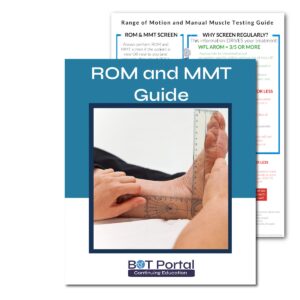Description
Toileting Goal How to write a goal for Occupational Therapy
This original document is for all occupational therapy students and practitioners searching for a good printable to guide you through How to Write a Toileting Goal for Occupational Therapy. In order to be a cutting-edge occupational therapy practitioner, you must have superb documentation skills. Writing goals for fundamental activities of daily living and instrumental activities of daily living is a paramount competency when becoming the best occupational therapy practitioner you can be! Download the ‘How to Write a Toileting Goal and a grooming goal for Occupational Therapy‘ printable for an easy guide to task analysis and goal creation of toileting activity during the occupational therapy process.
Background:
Occupational therapy practitioners write toileting and grooming goals through the lens of activity analysis to ensure that these activities are broken down into their component parts, making it easier to address specific functional deficits and develop targeted interventions. Here’s a detailed explanation of why this approach is beneficial:
1. Understanding the Complexity of Activities
Toileting and grooming are complex tasks that involve multiple steps and skills. By conducting an activity analysis, practitioners can identify each component of these activities, such as:
- Toileting: Transferring to and from the toilet, clothing management, hygiene, and washing hands.
- Grooming: Brushing teeth, washing face, combing hair, and shaving.
2. Identifying Specific Deficits
Activity analysis helps pinpoint specific deficits that may hinder a patient’s ability to perform these tasks independently. For example, a patient might struggle with fine motor skills needed for brushing teeth or lack the balance required for transferring to the toilet. By identifying these deficits, practitioners can create more precise and effective goals.
3. Individualized Goal Setting
Each patient has unique needs and abilities. Activity analysis allows practitioners to tailor goals to the specific challenges faced by the patient. For example, a toileting goal for one patient might focus on improving balance for safe transfers, while for another, it might involve increasing hand strength for better hygiene.
4. Enhancing Independence and Safety
By analyzing and addressing the individual steps involved in toileting and grooming, practitioners can help patients achieve greater independence and safety. For instance, if a patient is at risk of falls during toileting, the therapist can implement strategies such as grab bars or raised toilet seats as part of the goal.
5. Measuring Progress
Activity analysis provides a clear framework for measuring progress. Practitioners can track improvements in specific components of toileting and grooming tasks, making it easier to adjust interventions as needed and demonstrate progress to patients and caregivers.
6. Holistic Approach
Occupational therapy is holistic, considering physical, cognitive, emotional, and environmental factors. Activity analysis incorporates all these aspects, ensuring that goals are comprehensive and address all barriers to successful toileting and grooming.
7. Promoting Client-Centered Care
By involving patients in the activity analysis process, practitioners can ensure that goals are meaningful and relevant to the patient’s daily life. This engagement promotes motivation and adherence to the therapy plan, as patients see the direct relevance of their goals to their everyday activities.
8. Facilitating Collaboration with Other Professionals
Detailed activity analyses can be shared with other healthcare professionals involved in the patient’s care. This promotes a coordinated approach, ensuring that all team members are aware of the specific challenges and goals related to toileting and grooming.




